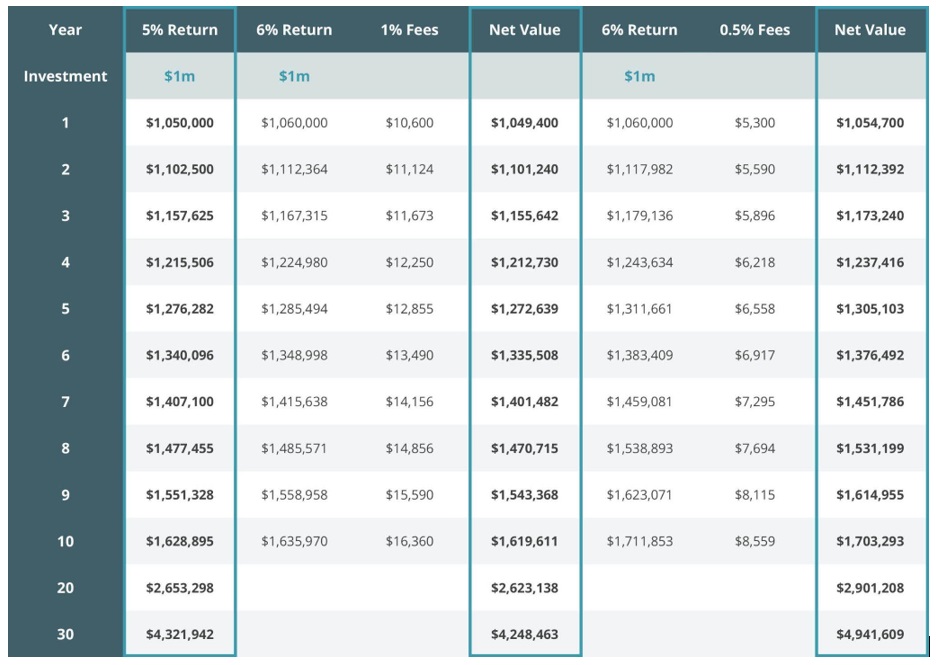The impact of costs on an investment portfolio
When it comes to financial advice, there is a very fine line between fair and reasonable charges and a detrimental impact on net investor returns. Cumulative charges can have a significant effect on overall investment returns. This is often referred to as the frictional impact of costs on long-term investment performance, and it can be fairly dramatic! Therefore, a financial advisor must add value to your portfolio, above and beyond their charges, to retain your long-term custom. In the investment world, returns can fluctuate significantly, and both
the investor and the advisor need to maintain a long-term view on net returns.
The cumulative impact of charges
The following table illustrates the long-term impact of charges on investment returns. This is referred to as the frictional impact because friction reduces speed. In this instance, the frictional impact of costs will slow the growth of your investment portfolio.

Many people might automatically assume that a 6% return less 1% fees is the same as a 5% net return. Unfortunately, this is not the case. Since the 1% annual fee is charged on the ever-increasing value of the portfolio, you would need to increase the gross return to 6.06% per annum to retain pace with a net 5% return.
You can also see the significant impact of the reduced 0.5% fee per annum on the overall return compared to a 1% fee. This equates to approaching $700,000 over 30 years. The cumulative fees over the period are as follows:-
● 1% fee, $697,038
● 0.5% fee, $381,910
But, and this is a big ‘but’, just because it’s cheaper, doesn’t mean you make more money. Far, far from it in fact. Indeed, being charged 1% per year for good all round financial planning and investing too indicates an advisor who knows their subject inside out and is comfortable justifying that spend with tax efficiency, and investment returns. This article is not to demonstrate that cheaper is always better, but to give you an idea of how costs must be justified by returns.
Know our clients
Although it may feel to some like prying, the more information we know about your financial picture now and prospects for the future, the better the advice we can provide. This is critical when looking to put together a plan for your tax affairs, taking advantage of allowances and other opportunities as soon as possible.
Many clients will have additional investments or assets elsewhere, perhaps not creating the returns they could or should. This may create additional opportunities to better invest these assets and increase the overall returns. Unfortunately, many people seem to pigeonhole investments, insurances, savings and other assets, seeking advice on each in isolation when they should be
considered together. In some cases, the existence of additional assets can make a massive difference to any financial advice, charges and, ultimately, returns.
The Internet has allowed those with experience in managing their financial affairs the opportunity to cut costs even further. However, those with less experience, and maybe not as confident, still require the services of a professional financial advisor. This is where a personal approach, taking an interest in a client’s life instead of just their financial affairs, can lay the foundation for a long and trusting relationship.
Long-term relationship
Akin to taking out car insurance, many of us will stay with the same financial advisor until we feel the costs are unjustified. In the example above, the difference in returns for a 1% annual charge and a 0.5% annual charge is vast in the longer term. If the charges are fair and consistent, and your advisor delivers on performance, chance are you’ll stay where you are. While cheap introductory offers can work in many industries, they are not so popular in the financial services sector. People expect to pay a fair rate for quality services; cheapening a service and brand will not necessarily instil trust or confidence.
As with any professional relationship, in the early days, you’re unlikely to hand over all of your investments until your advisor has proven themselves. If a financial advisor can deliver regularly, this is a considerable attraction for you, but it must be proven first.
Service: you get what you pay for
In reality, there are three different types of clients when it comes to financial services.
● Execution only
● Advisory
● Discretionary
Which do you feel you’d be most like? Well, you’ll need to know the differences first.
Execution-only clients don’t want advice at all. They just need a reliable, solid firm who can buy, sell, and administer their investments of choice for them. As such, they are perhaps more suited to low- cost electronic trading on the Internet. Companies providing these services work on volume, and not personal relationships, but the highly competitive nature of this corner of the market means cost competition is fierce, which works out very well for you, the client.
Advisory clients want to hear our recommendations and informed advice, but also to retain the choice to accept them or not. In contrast, discretionary clients hand over full control of the decision- making too. These are both very competitive areas, and performance will often trump everything. While some investors will look for sky-high returns, most are realistic. Interestingly, while we all want to make as much money as possible in our investments, slow and steady wins the race against volatile and unpredictable. Coping with returns 20% above or, more emotionally, below the relevant index isn’t easy!
Often, advisory services will see the advisor paid when the advice is accepted so you, the client, have far more cost-control than in discretionary relationships. But this isn’t the be all and end all. Advice is given because the advisor thinks it’ll be in your best interests to take it. Ignoring it simply to save costs is usually a false economy, because of the returns foregone, or the tax you pay unnecessarily.
Investing Styles
There are many, many styles when it comes to investing. Two of the main categories are active and passive, and opinion is split on which is better. Not to put too fine a point on it, you can dig up research which shows that passive investment has historically outperformed active investment over a prolonged period; and vice versa. There are so many variables.
Active investment
Active investing is, in essence, believing that it is possible to beat the average market return by using yours, or a professional money manager’s skills and strategy. It is split into two main groups: day (or at least regular) trading and long-term investing (sometimes called buy-and-hold though I don’t like that particular name as it implies you don’t sell!).
Short-term/day-trading is a phenomenon which has increased dramatically over the last decade, benefiting from the Covid lockdown, WFH, and the ‘second income’ movement, as well as (sarcasm activated) the increasing unwillingness to delay gratification. This could prove highly beneficial if you have the time, resources and knowledge to trade frequently on relatively low returns. However, you must be focused and regimental, using stop-loss limits to control your downside while running your winners.
There are many factors to take into consideration concerning active trading, which include:-
● Short-term timing is critical
● Frequent trading attracts higher accumulated dealing charges
● The temptation to remain fully invested
● Investors need to monitor prices very closely
● Opportunity to benefit from short-term share price spikes
● Acutely exposed to short-term market fluctuations and risk being out of the market when
sentiment turns
Long-term investors attempt to identify companies or assets who have better profit potential than
the average company or market. They are patient, not impulse-driven, and will hold until they feel they’ve seen fair value from their investment. This results in a far higher chance of being invested on the best days for that investment. The bets days make up the bulk of the returns, but the minority of the trading days! Long term investors will almost always suffer lower investment costs than active traders.
Passive investment
Passive investment is simply not believing it’s possible to outperform the market in general, and seeking the lowest cost way of capturing the average market return. A plethora of low cost passive investment vehicles cater for this market. Vanguard are the doyenne of the passive movement.
It, too, comes with pros and cons, when it comes to costs:-
● Less trading means less accumulated dealing charges
● Historically, passive investment tends to outperform active investment in the long-term in
some markets, but not others, so lower costs don’t always mean higher returns
Whether looking at active or passive investment, it is vital to know the pros and cons and how these may impact your overall investment returns.
Long-term relative performance is the yardstick
When comparing and contrasting the performance of investments, it is essential to look at these in relative terms. First of all, relative to the appropriate comparator index and then to the fees charged by your financial advisor. For example, if a financial adviser charges 0.5% per annum and can add more than 1% to the performance of your investments, this is acceptable. However, in reality, you
would look for an improvement well above double the charging level, which is very achievable with the right advisor. In any market, you get what you pay for, but this is perhaps more prevalent regarding financial services. The good news is it’s easy to determine which metrics are useful in making the decision. How well do they justify what they charge with what they make?
And finally
The cumulative impact of charges can significantly affect investment returns in the short, medium
and long term, but it really isn’t a race to the bottom in terms of costs. Low charging does not
guarantee better outcomes.
Get in touch
If you’d like to know more about this article, or how you can invest wisely to guarantee a better
future for yourself and your loved ones, get in touch today.
It costs nothing to have a conversation, and it could be one that changes your life.
Follow this link for a FREE investment review









